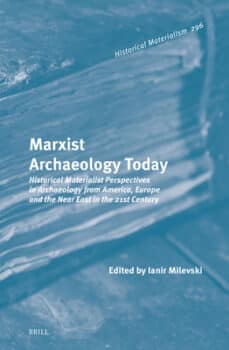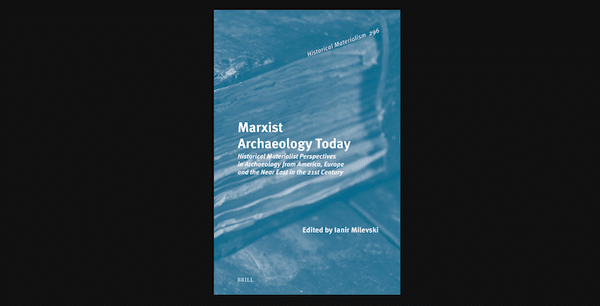
Ianir Milevski (ed)
Marxist Archeology Today: Historical Materialist Perspectives in Archeology from America, Europe and the Near East in the 21st Century. Brill, Historical Materialism Book Series, Vol. 296, Leiden/Boston, 2023. 334 pp., $185 hb
Archeology has always been a political science. Since its inception the field has attempted to trace our lineage as a species along the lines of identity, territory and culture. Though often portrayed as a discipline slightly closer to the hard sciences than historiography, it is much closer to its distant cousin in the social sciences than towards anything resembling an empirical practice. Having given an additional boost to nationalist positions of all stripes, archeology is embedded in politics and was shaped by the political systems from which it emerged. It has shaped not only how we imagine our shared past but also our collective present. One need only look at the now popular image of Napolean Bonaparte staring at the Sphinx in Egypt to analyze how he imagined his role in history in relation to that grand ancient monument and the history of empire from which it emerged. In short, archeology has always been linked to the ambitions of empire. All of these factors call for a counter-position to the predominant methodologies and has emerged within Marxist archeological circles as the recently published Marxist Archeology Today: Historical Materialist Perspectives in Archeology from America, Europe, and the Near East in the 21st Century.
The aim of Marxist Archeology Today is to present what the field of archeology can learn from Marxist theory and what Marxists can learn from archeological methods. It offers critiques of an older archeology rooted in orientalism, positivism and other reactionary currents still scraping for life within the humanities. Moving from ancient sites in Mexico and Peru to Palestine and beyond, the book covers large areas of debates and places. Wearing their thesis on their collective sleeve, each of these chapters manages to provide new insights for how we can analyze archeology through Marxist theory while maintaining important archeological practices which still reign within the field.
Chapter one covers ‘Work and Subsistence in Preceramic Groups of Southeastern Mexico’. On the surface this seems a rather pedantic subject, but is quite revealing of how this new form of social archeology attempts to historicize hunter-gatherer societies in contrast from how it has been done in the past. Unfortunately however, it does not start well. The authors begin by misquoting Karl Marx: ‘According to Marx, “work is the source of all wealth and all culture”. Under this principle, we start from the idea that archeological materials and contexts are the result of past human work (or objectified work in the form of ‘material culture’)’ (41). Marx famously issued a corrective to this quote, which had been falsely attributed to him in his Critique of the Gotha Programme: ‘Labor is not the source of all wealth. Nature is just as much the source of use values (and it is surely of such that material wealth consists!) as labor, which itself is only the manifestation of a force of nature, human labor power.’ Curiously, the footnote for this false quote is labeled: Marx 1979, although in reviewing the bibliography, no such source exists, and thankfully was not cited again.
Aside from this surprising blunder, the essay is still rather interesting in its ability to apply Marxist theory to both artefacts and to debates around social reproduction within the archeological community through an analysis of the Santa Marta rock shelter in southeastern Mexico. At one point the authors offer a succinct analysis of their methodology: ‘By evaluating the characteristics of the artefacts and their relations with the archeological context, it is possible to establish the basis of how these materials are inserted into daily life and to establish the elements that charaterise its mode of production.’ (68) The application of this thesis is rich in possibilities for how archeologists can analyze ancient sites of human life within a Marxist framework.
Chapter three is titled ‘An Exceptional Case of the Urban Revolution? A Marxist Perspective on the Preclassic Maya’ and falls short in its approach. First, there is no urban revolution to speak of in regards to class struggle, and the term ‘revolution’ refers more to the move from sedentary communities to largely productive, urban ones—more evolution than revolution. Second, inspired by Louis Althusser, it attempts to lay out an aleatory materialist perspective in analyzing the preclassic Mayan period as a way to distinguish the universalist approach of New World and Old World historiography dealing with pre-capitalist societies as leading towards inevitable capitalist development, no matter the hemisphere. In spite of this there is already a great deal of work that has largely rejected that universalist notion through Marxist theory. One need only cite Samir Amin’s Global History: A View from the South, where he historicizes the ancient world systems and their particular forms of development. Or even consider the many writings of Immanuel Wallerstein and the role of world-systems theory—that neither Amin, nor Wallerstein, were cited anywhere in this book is surprising in this regard. It is astonishing that the author moved to use aleatory materialism (albeit in a creative manner) to historicize the preclassic Maya since the approach is largely unnecessary when there are works already dealing with the idea that particular ancient societies often formed their own modes of production separately from others and did not naturally produce capitalist social relations.
In chapter five, the writers claim that ‘the study of objects brings us closer to social relations without intermediaries (oral and/or written). Therefore, archeological research is more transparent than historical sources that may contain biases or partitions.’ (138) Strangely, the writers do not consider their approach to have any potential pitfalls and attempt to separate archeology from historiography. Even though the drive towards using Marxism as a potential science—separate from history as a field of knowledge—is worthwhile, one would doubt that it already is a science in relation to archeology in particular or that it is without potential bias. While no historiography is without its reactionary tones, it seems pointless to pursue an archeology outside of its historical context.
It is well worth noting the important criticisms of apologists of the Roman Empire, ancient Greece and much of classical antiquity latent within chapter six. Scholar Steve Roskams deploys his Marxist archeological interpretation as ideological counter-insurgency against the prevailing narratives of empire and modernity in a manner that would make Edward Said proud. Roskams’ use of Marxist theory in analyzing the slave mode of production within ancient Roman and Greek society is useful for both archeologists and historians of the period.
Perhaps the most important chapter of the book deals with acclaimed archeologist Vere Gordon Childe and the founding of Latin American Social Archeology (LASA). In presenting the foundation of LASA, scholar Marcelo Vitores points to how it was influenced by Marxist analysis within the context of mid-twentieth century political upheaval across the region and how it grew to be an influential methodology at a time when archeology was still deeply rooted in conservative ideology. The scholars who followed in Childe’s footsteps were influenced by the Cuban Revolution, rejected French structuralism which was deeply in vogue at the time of their writing, and at many conferences across the Americas they attempted to reformulate historical materialism in their practice of archeology. Much of their work laid the groundwork for this book.
Although each of the chapters provides insightful inquiries into the development of a Marxist archeology, one would expect an essay dealing with the use of satellite imaging and the general relation of the field to technology used to unearth new sites across previously unknown locations. It seems odd that this Marxist current has not attempted to reverse the flippant theory of fully automated luxury communism towards archeology in asking the more productive question of what role this new technology could play in analyzing the ancient past, what role Marxist archeologists could play within it and what the implications might be.
Finally, although the book was published less than a month prior to the October 7th Palestinian guerilla military operations against Israel, it seems impossible now to think about a Marxist archeology which does not include an analysis of both the national question and the agrarian question, each of which are fundamental hallmarks of Marxist theory in regards to thinking through the history of class struggle. Viewing land from this socio-political perspective should certainly be a crucial component for any future Marxist archeology in regards to the still raging colonial situations in Palestine, North America, the north of Ireland, Australia and other places.
It is well worth noting that Marxist Archeology Today was clearly written for archeologists and those well-schooled in Marxist theory, so some precaution should be taken for the general reader as the book was not written for a popular audience—though this is less a matter of discursive pyrotechnics than it is of dense content. Even so, this does not diminish the significant accomplishment of putting together such an important volume for future research into Marxist archeological methodology. And thankfully the book is less an exercise in theory than it is in advocating for concrete archeological practice. The writers keep their arguments succinct with their aim in developing archeology towards a new future. Marxist Archeology Today is not only groundbreaking for the field, it is also an opportunity for Marxists to learn from archeology and how we can shape the practice to our own advantage.

